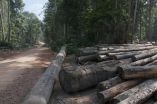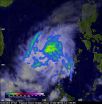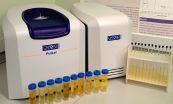Reduced-impact logging supports diversity of forests almost as well as leaving them alone
2014-12-01
(Press-News.org) When it comes to logging, it may be possible to have our timber and our tropical forests, too. The key, according to a report in the Cell Press journal Current Biology on December 1, is careful planning and the use of reduced-impact logging (RIL) practices that avoid unnecessary damage to the surrounding forest.
"Four million square kilometres of tropical forest are designated for logging globally," says Jake Bicknell of the University of Kent in the United Kingdom, noting that this represents an area larger than the size of India. "Even if we could improve timber harvesting operations across a proportion of this area, the benefits for biodiversity and its conservation would be very substantial indeed."
RIL practices reduce the level of damage within the forest that is caused by tree harvesting, Bicknell explains. Those practices include well-planned logging roads, directional felling so that cut trees do not crush those that should be left standing, and cutting vines that might otherwise pull nearby trees down along with those marked for cutting.
The researchers conducted a meta-analysis of studies that compared diversity in primary tropical forest using conventional logging and RIL. They found consistently lower effects of RIL in comparison to conventional logging practices, with smaller shifts in species abundance following RIL logging. RIL logging appears to cause less harm to birds, arthropods, mammals, and especially bats.
The new study comes as welcome news following another report in Current Biology showing that even the removal of very few trees can have a devastating impact on forest animals, and on mammals and amphibians in particular. The latest study suggests that this is because "harvest intensities are not always indicative of actual disturbance levels resulting from logging." In many cases, plenty of unnecessary damage to the forest is being done.
Consumers can do their part by demanding wood that is RIL certified, although it may be hard to come by for now. Currently, less than five percent of timber production forests meet that standard. Bicknell nevertheless sees reason for optimism.
"The guidelines are already in place, the logging techniques are available, and the expertise exists, so there is little excuse for timber companies not to implement RIL," he says. "Economically, RIL can bring greater profits to timber companies over the long term, although the initial expenses may be slightly greater than with conventional practices.
"The issue is now advocating the diverse benefits of RIL to stimulate widespread uptake of the techniques. If policy makers and companies respond to the growing scientific evidence-base and move away from the business-as-usual scenario, then I am confident that future prospects for tropical forests and the biodiversity they contain will be much improved."
INFORMATION:
Current Biology, Bicknell et al.: "Improved timber harvest techniques maintain biodiversity in tropical forests"
[Attachments] See images for this press release:

ELSE PRESS RELEASES FROM THIS DATE:
2014-12-01
Researchers have identified the cause for a disorder common in Inuit people that prevents the absorption of sucrose, causing gastrointestinal distress and failure to thrive in infants. The study, published in CMAJ (Canadian Medical Association Journal), identified a genetic mutation responsible for the disorder, called congenital sucrose-isomaltase deficiency (CSID).
CSID is a rare disorder in people of European descent, but is more common in Inuit people living in northern Canada, Greenland and Alaska, with rates estimated between 5% and 10%. The disorder prevents the ...
2014-12-01
In recent years, cilia, microscopic, tentacle-like extensions from biological cells, have risen from relative obscurity and are now considered important to the understanding of many human afflictions. In a December BioScience article, George B. Witman, of the University of Massachusetts Medical School, and Jason M. Brown, of Salem State University, describe recent discoveries involving cilia-related diseases (called "ciliopathies") and highlight "model" species that could be useful for systematic study of ciliopathies.
Cilia perform a broad range of functions, including ...
2014-12-01
Tropical Storm Sinlaku made landfall in east-central Vietnam bringing some moderate to heavy rainfall with it. NASA and the Japan Aerospace Exploration Agency's TRMM and GPM satellites analyzed the rainfall rates occurring in Sinlaku before it made landfall while NASA's Terra satellite spotted the storm as it came ashore in Vietnam.
Tropical Storm Sinlaku formed on November 26, 2014 over the southeastern Philippines. As a tropical depression Sinlaku caused flooding in areas of the Visayas and Mindanao. The storm then moved west and crossed the South China Sea where it ...
2014-12-01
Scientists at the Institute of Food Research on the Norwich Research Park have teamed up with Oxford Instruments to develop a fast, cheap alternative to DNA testing as a means of distinguishing horse meat from beef. Because horses and cattle have different digestive systems, the fat components of the two meats have different fatty acid compositions, as the team report in the journal 'Food Chemistry'. The new method looks at differences in the chemical composition of the fat in the meats, using similar technology to a hospital MRI scanner.
In just ten minutes, a technician ...
2014-12-01
December 1, 2014 - The health departments of the nation's largest cities play a central role in developing innovative population health strategies for improving public health across the United States, according to a special January issue of the Journal of Public Health Management and Practice. The journal is published by Lippincott Williams & Wilkins, a part of Wolters Kluwer Health.
"Indeed, cities are at the forefront in extending public health and social policy to realize changes in our environment abetting population health," according to a commentary by Lloyd F. ...
2014-12-01
ROSEMONT, Ill.--Prompt and appropriate treatment of a dislocated shoulder--when the head of the upper arm bone (humerus) is completely knocked out of the shoulder socket (glenoid)--can minimize risk for future dislocations as well as the effects of related bone, muscle and nerve injuries, according to a literature review appearing in the December issue of the Journal of the American Academy of Orthopaedic Surgeons (JAAOS).
The shoulder has the greatest range of motion of any joint in the human body and is the most common site for a full or partial dislocation. Shoulder ...
2014-12-01
This news release is available in German. Ideally, diamonds consist of pure carbon. But natural diamonds always contain defects. The most researched defects are nitrogen-vacancy centers comprising a nitrogen atom and a vacancy. These might serve as highly sensitive sensors or as register components for quantum computers. However, until now it has not been possible to extract the optically stored information electronically.
A team headed by Professor Alexander Holleitner, physicist at the TU München and Frank Koppens, physics professor at the Institut de Ciencies ...
2014-12-01
Conflicting evidence about the extent to which men's semen quality declines with age--likely lowering their fertility--is being cleared up by new University of Otago, New Zealand, research that has collated and reviewed data from 90 previous studies from around the world.
After conducting a systematic review and meta-analysis of the studies' data, researchers from the University's Departments of Zoology and Anatomy found consistent age-related declines in semen volume and sperm performance and increases in malformed and DNA-damaged sperm. Semen quality is regarded as ...
2014-12-01
Singapore--Scientists at A*STAR's Genome Institute of Singapore (GIS), in collaboration with local clinicians and colleagues in the USA, have identified a biomarker which is strongly associated with triple negative breast cancer (TNBC), a highly aggressive carcinoma that often has early relapse and metastasis following chemotherapy. The newly identified biomarker, a gene called RASAL2, provides a target for developing new therapeutics designed to treat this often deadly disease.
TNBC is deadly because, unlike other types of breast cancers such as estrogen receptor (ER) ...
2014-12-01
Personalized medicine uses methods of molecular analysis, especially genetic sequencing and transcription, in order to simultaneously identify genetic mutations to evaluate each individual's risk of contracting a given disease. It seems that there is more than a single mechanism at hand, as proven by the work of a team of geneticists at the University of Geneva's (UNIGE) Faculty of Medicine, and the Swiss Institute for Bioinformatics (SIB). They have sequenced the RNA of 400 pairs of twins; with this information, they can quantify the roles of both genetic and environmental ...
LAST 30 PRESS RELEASES:
[Press-News.org] Reduced-impact logging supports diversity of forests almost as well as leaving them alone



